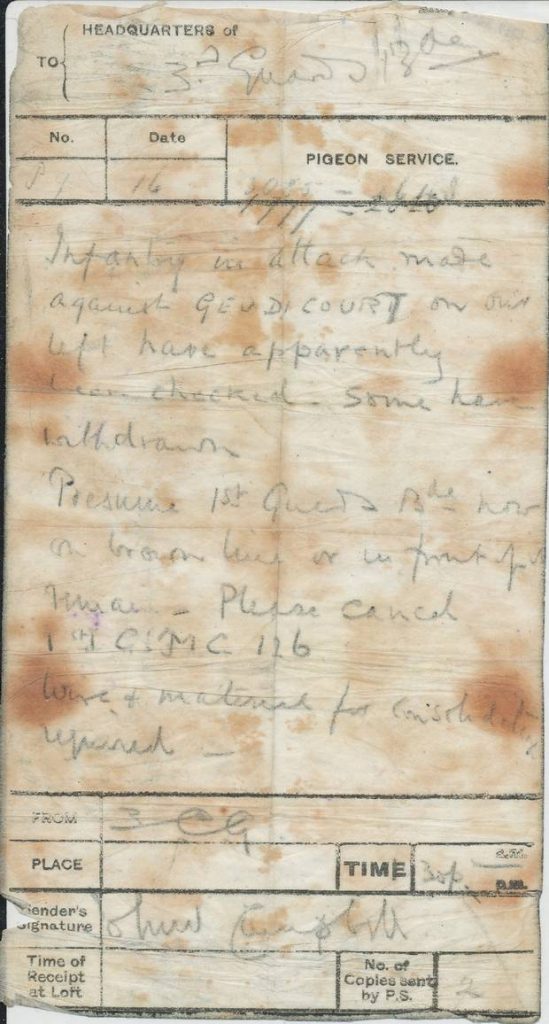Earlier this month, prior to the 100th anniversary of the end of the Battle of the Somme, Royal Mail released three letters sent to and from soldiers fighting in the conflict, offering a glimpse into life on the front line and at home.
The letters—unearthed as part of Royal Mail’s Letters of Our Lives project—paint an intimate picture of the soldiers’ bravery, showing the unfaltering cheerful attitude of those on the front line; however, this is contrasted by the struggles faced by the families back home. Altogether, the Battle of the Somme saw more than one million men killed or wounded on both sides.
As part of Letters of Our Lives, Royal Mail asked people to search around for any letters or postcards relating to key moments in their family history.
“We have received thousands of letters so far and a large number of those were written during wartime. Letters and parcels became a vital communication channel between those at home and those stationed abroad,” said David Gold, head of public affairs at Royal Mail. “On average 12 million letters and a million parcels were processed a week at an enormous wooden temporary sorting office in Regent’s Park.”
“These letters show both sides of the battle depicting the amazing feats of bravery that soldiers undertook on a daily basis and the endless struggles that families faced at home under extreme conditions,” added Gold.
For images from the Letters of Our Lives project, visit royalmail.photodeck.com.
COL. JOHN VAUGHN CAMPBELL
The first letter was submitted by Norman Watson, of Perth, and was written by Colonel John Vaughn Campbell. The note was written on the battlefields of the Somme on Sept. 16, 1916, only hours after Col. Campbell took command of his battalion when it came under fire from German machine-guns. Campbell managed to rally the men and after a long fought battle captured the guns.
The following day, he scribbled this note, which was rolled up and transported in a tiny aluminium cylinder by pigeon to the two mobile lofts at Brigade Headquarters. In it he reports the “Infantry in attack made against Geudecourt on our left have apparently been checked. Some have withdrawn,” which is a reference to the British offensive at Gueudecourt, France. The Colonel requests information about the position of the 1st Guards Brigade and ends his message with a plea for material to restore his defences—”Wire material for consolidating required”—the duckboards, coils of barbed wire, corrugated iron, stakes and sandbags necessary for trench warfare. The message is signed “John Campbell,” from the “3 CG” (3rd Coldstream Guards).
This extraordinary feat of bravery won Colonel Campbell Britain’s highest honour for gallantry, the Victoria Cross (VC). According to his VC citation, his gallantry enabled the Allies to capture objectives of the highest importance.
PTE. JOE PEARCE
The second letter was submitted by Christopher Vellenoweth, the Wirral, and was written by his uncle, Private Joe Pearce, who was a member of the 5th Company 3rd Battalion Royal Sussex Regiment.
Written on Oct. 29, 1916, Pearce talks about life on the front line and how the weather is “absolutely rotten” with “rain and mud up to our ankles”. He goes on to say they “don’t mind though as we know that old is beaten.”
Pearce, who was 24 years old at the time of writing, adds he is “quite cheerful” and is “amongst some good lads” with a “tale to unfold when [he] returns” home. His cheerful tone remains steadfast throughout even when writing about “us fellows taking as much cover as possible as old Fritz was sending over a few Whiz Bangs.”
Sadly, Pearce was killed in action on Nov. 18, 1916, the last official day of the Somme, during the assault on Grandcourt, a village 12 kilometres north-east of Albert, France. He was awarded the Victory medal and British Star and is buried in Stump Road Cemetery, Grandcourt.
NELLIE GREEN
The final letter depicts the battles of home life and the tribulations of bringing up a family during the war. It was submitted by Sarah Green, of Wales, and was written by her great-grandmother, Nellie, who was writing to her husband, John “Jack” Coupe.
She writes Coupe, who was away fighting, and said she has been forced to “give up work” due to ill health. She comments the money from working was a “good help” as “what food you can get is a terrible price”. She also goes on to say she is looking forward to Coupe coming home for leave, although it “seems as far of as ever”. She remarks “no man has to be out twelve months without a leave”, adding he has been “out thirteen”. She also says another serviceman has been “home again for a fortnight [despite the fact] it is only eight months since he has had last leave.”
She also comments about eating “dry bread and black treacle” after all their rations have gone, adding the family “shall not get fat”.
She closes the letter saying she hopes to see Coupe “home for Easter” and asks if there is “any chance”.
Sadly, Coupe was killed five days before Easter during the Battle of the Somme. He’s buried at the war cemetery in Harbonnieres.

